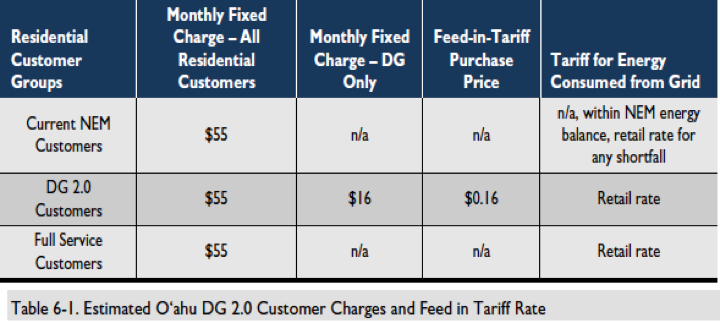By Sherilyn Wee and Makena Coffman
Public comments regarding Hawaiian Electric’s PSIP and DGIP were due last week. Here’s a recap of what Hawaiian Electric has proposed for rooftop solar PV.
Hawai’i is characterized with small island electricity grids and some of the highest rates of solar PV penetration in the world. With over 10% of O’ahu households having PV, exceeding that of any mainland utility, the Hawaiian Electric Company and its subsidiaries have recently stalled the interconnection of new systems. The Hawai’i Public Utilities Commission ordered that further study be completed that might facilitate the adoption of more solar PV in Hawai’i. Along with circuit and power system upgrades, Hawaiian Electric’s Distributed Generation Improvement Plan (DGIP) devises an alternative rate design that increases the interconnection fee and makes it more favorable to the utility to allow more households to install solar PV. Hawaiian Electric projects that DG customers could triple to upwards of 900 MW, while reducing the cost shift to non-DG customers, which they estimate to the tune of $38 million in 2013, or $31 for each non-DG customer.
In Hawaiian Electric’s proposed tariff structure, referred to as “Gross Export Purchase program,” all residential customer groups—current Net Energy Metering (NEM) customers, “DG 2.0” customers, and “Full Service” customers (non-DG)—incur a fixed monthly charge of $55 and pay retail rate for any energy consumed from the grid. The idea of the Gross Export Purchase Program is to account for some combination of interconnection and grid service charges. The first major proposal is to switch the NEM program to one where customers are compensated at wholesale rates rather than retail rates (similar to KIUC and many other utilities). This is to account for, as Hawaiian Electric puts it, “the value of DG to the grid.” Following the duck-shaped load curve, the bulk of electricity generation from DG occurs during the day, while peak consumption occurs in the late afternoon/early evening. Under the current rate structure, DG providers are providing “cheap” electricity while consuming “expensive” electricity. Current NEM customers will be grandfathered according to their original agreement (i.e. the utility pays retail rate in credits which expire at the end of the calendar year). Future NEM customers, called DG 2.0, will pay an additional monthly fixed charge of $16 and any excess electricity generated would be compensated at the lower rate of 16¢/kWh, reflecting that of wholesale rates.

The second proposal is to quicken interconnection for what is termed the “non-export option.” It allows customers to offset their electricity use so long as they do not send excess generation to the grid. The non-export option includes several variations. There are those that operate in parallel with the distribution system (grid-interactive) and with or without customer-side energy storage; and those that are independent from the grid (non-parallel operation) and with energy storage. A type of parallel non-export system without energy storage is an over-installed system under Hawaiian Electric’s Standard Interconnect Agreement—where there is a possibility for energy to “leak” back to the grid, though the customer receives no compensation. On the other hand, systems configured for non-parallel operation serve only an isolated load, thereby negating any possibility for reverse power flow into the distribution network. As filed in Docket 2014-0130, non-parallel systems are therefore eligible to bypass the full screening process under Rule 14H. Systems that have the potential to operate in parallel may also be granted expedited approval if reverse power protection measures, such as stand-alone inverters, is installed.
Will it Increase PV Installations?
The underlying question remains—will PV installations increase under Hawaiian Electric’s proposal? Certainly the change away from retail to wholesale rates for NEM customers, along with technical upgrades, increases utility revenue and its incentive to allow for more PV system connections. It also decreases potential customers incentive to install solar PV – though arguably the return on investment has been remarkably high and customers are still likely to install even if incentives decline slightly. Moreover, there is an element of increased fairness to non-DG customers through the revised NEM rates (assuming savings are passed through accordingly). So the answer is, it depends. On the continued decline of PV system costs, tax credits, the cost of battery technology and electricity rates. Whereas a decline in battery technology costs might lead to increased solar PV yet fewer connections to the grid, declining electricity rates would have the opposite effect. Within Hawaiian Electric’s proposal, they also project substantial cost savings primarily due to the introduction of LNG. This, however, is a more long-term endeavor than the granting of near-term solar PV permits.
BLOG POSTS ARE PRELIMINARY MATERIALS CIRCULATED TO STIMULATE DISCUSSION AND CRITICAL COMMENT. THE VIEWS EXPRESSED ARE THOSE OF THE INDIVIDUAL AUTHORS. WHILE BLOG POSTS BENEFIT FROM ACTIVE UHERO DISCUSSION, THEY HAVE NOT UNDERGONE FORMAL ACADEMIC PEER REVIEW.



